Chen-Yu Lee
In Prospect and Retrospect: Reflective Memory Management for Long-term Personalized Dialogue Agents
Mar 11, 2025Abstract:Large Language Models (LLMs) have made significant progress in open-ended dialogue, yet their inability to retain and retrieve relevant information from long-term interactions limits their effectiveness in applications requiring sustained personalization. External memory mechanisms have been proposed to address this limitation, enabling LLMs to maintain conversational continuity. However, existing approaches struggle with two key challenges. First, rigid memory granularity fails to capture the natural semantic structure of conversations, leading to fragmented and incomplete representations. Second, fixed retrieval mechanisms cannot adapt to diverse dialogue contexts and user interaction patterns. In this work, we propose Reflective Memory Management (RMM), a novel mechanism for long-term dialogue agents, integrating forward- and backward-looking reflections: (1) Prospective Reflection, which dynamically summarizes interactions across granularities-utterances, turns, and sessions-into a personalized memory bank for effective future retrieval, and (2) Retrospective Reflection, which iteratively refines the retrieval in an online reinforcement learning (RL) manner based on LLMs' cited evidence. Experiments show that RMM demonstrates consistent improvement across various metrics and benchmarks. For example, RMM shows more than 10% accuracy improvement over the baseline without memory management on the LongMemEval dataset.
Magnet: Multi-turn Tool-use Data Synthesis and Distillation via Graph Translation
Mar 10, 2025Abstract:Large language models (LLMs) have exhibited the ability to effectively utilize external tools to address user queries. However, their performance may be limited in complex, multi-turn interactions involving users and multiple tools. To address this, we propose Magnet, a principled framework for synthesizing high-quality training trajectories to enhance the function calling capability of large language model agents in multi-turn conversations with humans. The framework is based on automatic and iterative translations from a function signature path to a sequence of queries and executable function calls. We model the complicated function interactions in multi-turn cases with graph and design novel node operations to build reliable signature paths. Motivated by context distillation, when guiding the generation of positive and negative trajectories using a teacher model, we provide reference function call sequences as positive hints in context and contrastive, incorrect function calls as negative hints. Experiments show that training with the positive trajectories with supervised fine-tuning and preference optimization against negative trajectories, our 14B model, Magnet-14B-mDPO, obtains 68.01 on BFCL-v3 and 73.30 on ToolQuery, surpassing the performance of the teacher model Gemini-1.5-pro-002 by a large margin in function calling.
PlanGEN: A Multi-Agent Framework for Generating Planning and Reasoning Trajectories for Complex Problem Solving
Feb 22, 2025Abstract:Recent agent frameworks and inference-time algorithms often struggle with complex planning problems due to limitations in verifying generated plans or reasoning and varying complexity of instances within a single task. Many existing methods for these tasks either perform task-level verification without considering constraints or apply inference-time algorithms without adapting to instance-level complexity. To address these limitations, we propose PlanGEN, a model-agnostic and easily scalable agent framework with three key components: constraint, verification, and selection agents. Specifically, our approach proposes constraint-guided iterative verification to enhance performance of inference-time algorithms--Best of N, Tree-of-Thought, and REBASE. In PlanGEN framework, the selection agent optimizes algorithm choice based on instance complexity, ensuring better adaptability to complex planning problems. Experimental results demonstrate significant improvements over the strongest baseline across multiple benchmarks, achieving state-of-the-art results on NATURAL PLAN ($\sim$8%$\uparrow$), OlympiadBench ($\sim$4%$\uparrow$), DocFinQA ($\sim$7%$\uparrow$), and GPQA ($\sim$1%$\uparrow$). Our key finding highlights that constraint-guided iterative verification improves inference-time algorithms, and adaptive selection further boosts performance on complex planning and reasoning problems.
Universal Model Routing for Efficient LLM Inference
Feb 12, 2025



Abstract:Large language models' significant advances in capabilities are accompanied by significant increases in inference costs. Model routing is a simple technique for reducing inference cost, wherein one maintains a pool of candidate LLMs, and learns to route each prompt to the smallest feasible LLM. Existing works focus on learning a router for a fixed pool of LLMs. In this paper, we consider the problem of dynamic routing, where new, previously unobserved LLMs are available at test time. We propose a new approach to this problem that relies on representing each LLM as a feature vector, derived based on predictions on a set of representative prompts. Based on this, we detail two effective strategies, relying on cluster-based routing and a learned cluster map respectively. We prove that these strategies are estimates of a theoretically optimal routing rule, and provide an excess risk bound to quantify their errors. Experiments on a range of public benchmarks show the effectiveness of the proposed strategies in routing amongst more than 30 unseen LLMs.
When One LLM Drools, Multi-LLM Collaboration Rules
Feb 06, 2025Abstract:This position paper argues that in many realistic (i.e., complex, contextualized, subjective) scenarios, one LLM is not enough to produce a reliable output. We challenge the status quo of relying solely on a single general-purpose LLM and argue for multi-LLM collaboration to better represent the extensive diversity of data, skills, and people. We first posit that a single LLM underrepresents real-world data distributions, heterogeneous skills, and pluralistic populations, and that such representation gaps cannot be trivially patched by further training a single LLM. We then organize existing multi-LLM collaboration methods into a hierarchy, based on the level of access and information exchange, ranging from API-level, text-level, logit-level, to weight-level collaboration. Based on these methods, we highlight how multi-LLM collaboration addresses challenges that a single LLM struggles with, such as reliability, democratization, and pluralism. Finally, we identify the limitations of existing multi-LLM methods and motivate future work. We envision multi-LLM collaboration as an essential path toward compositional intelligence and collaborative AI development.
Heterogeneous Swarms: Jointly Optimizing Model Roles and Weights for Multi-LLM Systems
Feb 06, 2025



Abstract:We propose Heterogeneous Swarms, an algorithm to design multi-LLM systems by jointly optimizing model roles and weights. We represent multi-LLM systems as directed acyclic graphs (DAGs) of LLMs with topological message passing for collaborative generation. Given a pool of LLM experts and a utility function, Heterogeneous Swarms employs two iterative steps: role-step and weight-step. For role-step, we interpret model roles as learning a DAG that specifies the flow of inputs and outputs between LLMs. Starting from a swarm of random continuous adjacency matrices, we decode them into discrete DAGs, call the LLMs in topological order, evaluate on the utility function (e.g. accuracy on a task), and optimize the adjacency matrices with particle swarm optimization based on the utility score. For weight-step, we assess the contribution of individual LLMs in the multi-LLM systems and optimize model weights with swarm intelligence. We propose JFK-score to quantify the individual contribution of each LLM in the best-found DAG of the role-step, then optimize model weights with particle swarm optimization based on the JFK-score. Experiments demonstrate that Heterogeneous Swarms outperforms 15 role- and/or weight-based baselines by 18.5% on average across 12 tasks. Further analysis reveals that Heterogeneous Swarms discovers multi-LLM systems with heterogeneous model roles and substantial collaborative gains, and benefits from the diversity of language models.
Exemplar Masking for Multimodal Incremental Learning
Dec 12, 2024Abstract:Multimodal incremental learning needs to digest the information from multiple modalities while concurrently learning new knowledge without forgetting the previously learned information. There are numerous challenges for this task, mainly including the larger storage size of multimodal data in exemplar-based methods and the computational requirement of finetuning on huge multimodal models. In this paper, we leverage the parameter-efficient tuning scheme to reduce the burden of fine-tuning and propose the exemplar masking framework to efficiently replay old knowledge. Specifically, the non-important tokens are masked based on the attention weights and the correlation across different modalities, significantly reducing the storage size of an exemplar and consequently saving more exemplars under the same memory buffer. Moreover, we design a multimodal data augmentation technique to diversify exemplars for replaying prior knowledge. In experiments, we not only evaluate our method in existing multimodal datasets but also extend the ImageNet-R dataset to a multimodal dataset as a real-world application, where captions are generated by querying multimodal large language models (e.g., InstructBLIP). Extensive experiments show that our exemplar masking framework is more efficient and robust to catastrophic forgetting under the same limited memory buffer. Code is available at https://github.com/YiLunLee/Exemplar_Masking_MCIL.
Reverse Thinking Makes LLMs Stronger Reasoners
Nov 29, 2024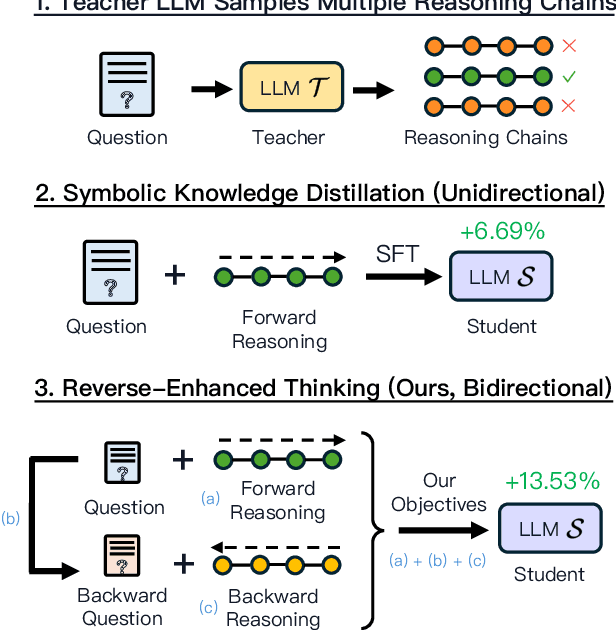
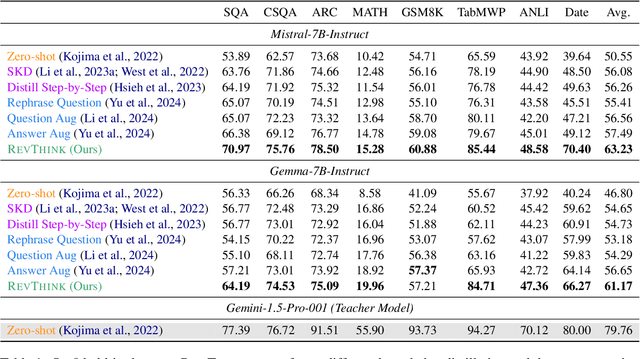
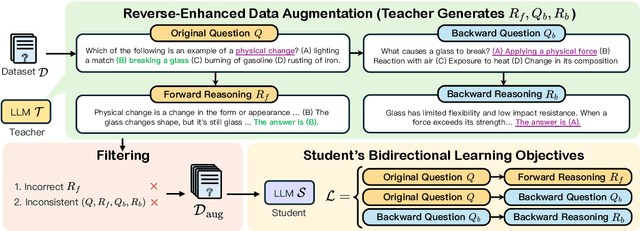

Abstract:Reverse thinking plays a crucial role in human reasoning. Humans can reason not only from a problem to a solution but also in reverse, i.e., start from the solution and reason towards the problem. This often enhances overall reasoning performance as it enables consistency checks between their forward and backward thinking. To enable Large Language Models (LLMs) to perform reverse thinking, we introduce Reverse-Enhanced Thinking (RevThink), a framework composed of data augmentation and learning objectives. In RevThink, we augment the dataset by collecting structured forward-backward reasoning from a teacher model, consisting of: (1) the original question, (2) forward reasoning, (3) backward question, and (4) backward reasoning. We then employ three objectives to train a smaller student model in a multi-task learning fashion: (a) generate forward reasoning from a question, (b) generate a backward question from a question, and (c) generate backward reasoning from the backward question. Experiments across 12 datasets covering commonsense, math, and logical reasoning show an average 13.53% improvement over the student model's zero-shot performance and a 6.84% improvement over the strongest knowledge distillation baselines. Moreover, our method demonstrates sample efficiency -- using only 10% of the correct forward reasoning from the training data, it outperforms a standard fine-tuning method trained on 10x more forward reasoning. RevThink also exhibits strong generalization to out-of-distribution held-out datasets.
Model Swarms: Collaborative Search to Adapt LLM Experts via Swarm Intelligence
Oct 15, 2024
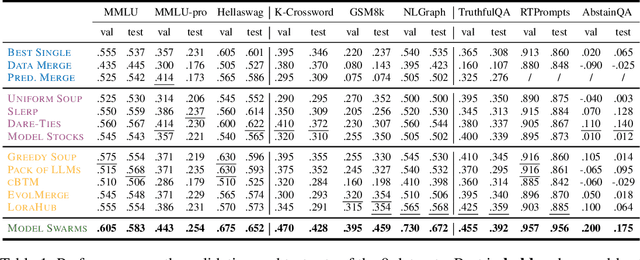
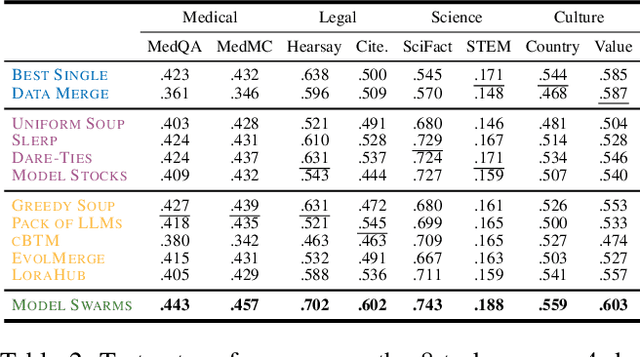

Abstract:We propose Model Swarms, a collaborative search algorithm to adapt LLMs via swarm intelligence, the collective behavior guiding individual systems. Specifically, Model Swarms starts with a pool of LLM experts and a utility function. Guided by the best-found checkpoints across models, diverse LLM experts collaboratively move in the weight space and optimize a utility function representing model adaptation objectives. Compared to existing model composition approaches, Model Swarms offers tuning-free model adaptation, works in low-data regimes with as few as 200 examples, and does not require assumptions about specific experts in the swarm or how they should be composed. Extensive experiments demonstrate that Model Swarms could flexibly adapt LLM experts to a single task, multi-task domains, reward models, as well as diverse human interests, improving over 12 model composition baselines by up to 21.0% across tasks and contexts. Further analysis reveals that LLM experts discover previously unseen capabilities in initial checkpoints and that Model Swarms enable the weak-to-strong transition of experts through the collaborative search process.
Speculative Knowledge Distillation: Bridging the Teacher-Student Gap Through Interleaved Sampling
Oct 15, 2024



Abstract:Recent advances in knowledge distillation (KD) have enabled smaller student models to approach the performance of larger teacher models. However, popular methods such as supervised KD and on-policy KD, are adversely impacted by the knowledge gaps between teacher-student in practical scenarios. Supervised KD suffers from a distribution mismatch between training with a static dataset and inference over final student-generated outputs. Conversely, on-policy KD, which uses student-generated samples for training, can suffer from low-quality training examples with which teacher models are not familiar, resulting in inaccurate teacher feedback. To address these limitations, we introduce Speculative Knowledge Distillation (SKD), a novel approach that leverages cooperation between student and teacher models to generate high-quality training data on-the-fly while aligning with the student's inference-time distribution. In SKD, the student proposes tokens, and the teacher replaces poorly ranked ones based on its own distribution, transferring high-quality knowledge adaptively. We evaluate SKD on various text generation tasks, including translation, summarization, math, and instruction following, and show that SKD consistently outperforms existing KD methods across different domains, data sizes, and model initialization strategies.
 Add to Chrome
Add to Chrome Add to Firefox
Add to Firefox Add to Edge
Add to Edge